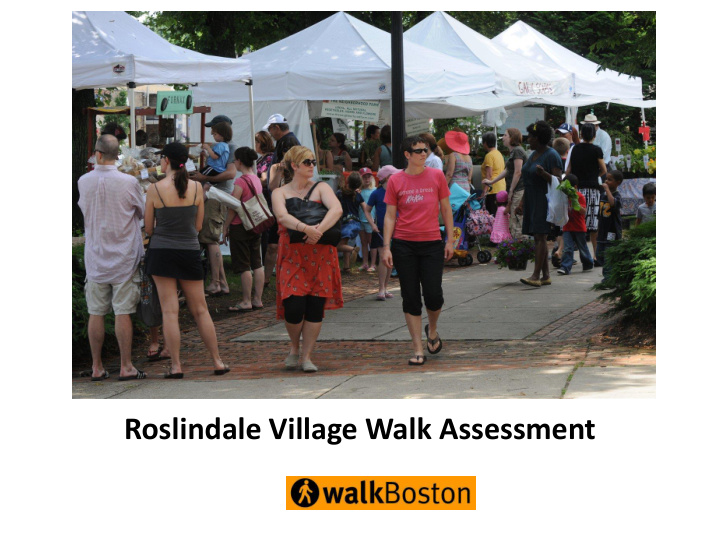



Roslindale Village Walk Assessment
Walk Assessment Introduce all participants Discuss basics of walking infrastructure Walk through Roslindale Village Discuss observations and recommend improvements Next Steps: Review report/submit comments
Walk Assessment
Purpose of a walk assessment • Foster an awareness of the elements that contribute to the walking environment • Evaluate the safety and quality of the walking experience • Recommend improvements
Pedestrian probability of death 100 80 % chance of death 60 40 20 20 mph 30 mph 40 mph
Road design methods to slow traffic • narrow lane widths • curb extensions • raised crosswalks • pavement markings • parking buffers
Lane widths • lanes should be no wider than 11 feet on main streets • narrowing a travel lane from 11 feet to 10 feet reduces speed by 7 mph • striping can cut a 16 -foot lane down to an 11-foot lane
Curb extensions • shorten crossing distance • make walkers more visible • provide larger waiting areas • can provide informal public spaces
Crosswalks • two parallel lines is standard • ladder is much more visible and widely recognized: worth the extra cost • should be repainted regularly: visibility is key to effectiveness
Safer crossings • raised crosswalks (aka speed tables) are visual, acoustical and physical reminders to slow down • in street crosswalk signs effectively warn drivers of mid -block crossings
Parking • slows traffic • buffers walkers from traffic
Pedestrian elements that improve safety and comfort: • pedestrian countdown signals • wide, continuous, smooth sidewalks • few curb cuts; tight curb radii • separation from curb (verge) • street furnishings (trees and benches)
Signal timing • studies show that when countdown lights are installed at a high accident intersection, pedestrian accidents drop by 50% • eliminating push buttons guarantees walkers always get a WALK signal
Passable sidewalks • sidewalks should be continuous, unobstructed and clear • hedges and trees should be trimmed
Curb cuts and continuous sidewalks • driveways/entryways should be narrow with flat, continuous sidewalks • limit frequency: sidewalks are the pedestrian zone • slope should be moderate and minimized as much as possible
Continuous sidewalks across driveways • Continuous slope and material across driveway delineates pedestrian path
Tight curb radii • Requires drivers to slow down when turning into the driveway • Can be temporary installation or more permanent solution
Separation between the walkway and moving traffic • trees or landscape strip • parking/pavement change delineates sidewalk edge
Trees, benches, trash receptacles • pedestrian scale elements that make people feel like they belong • add vibrancy to downtown center
Recommend
More recommend